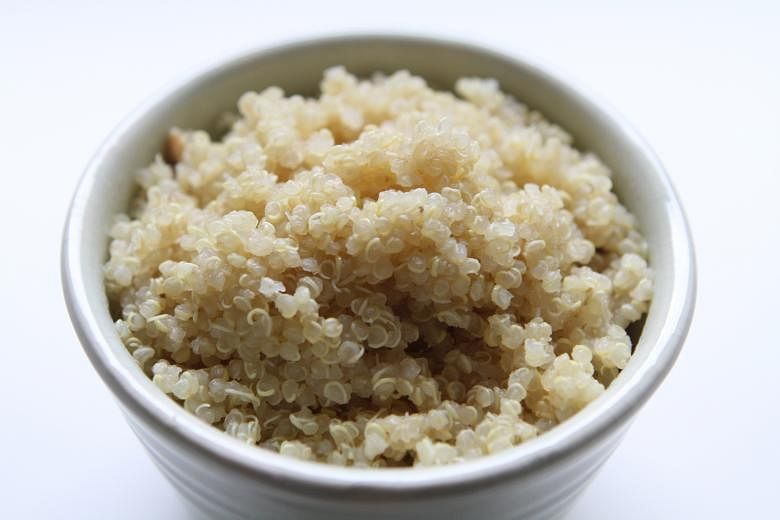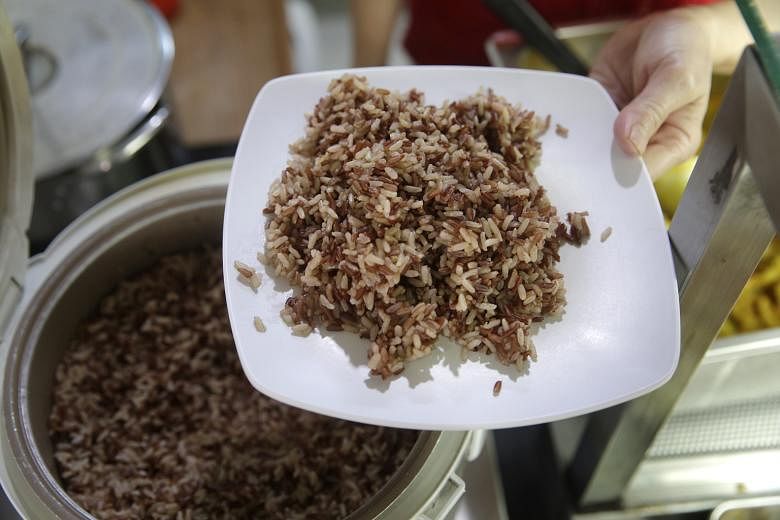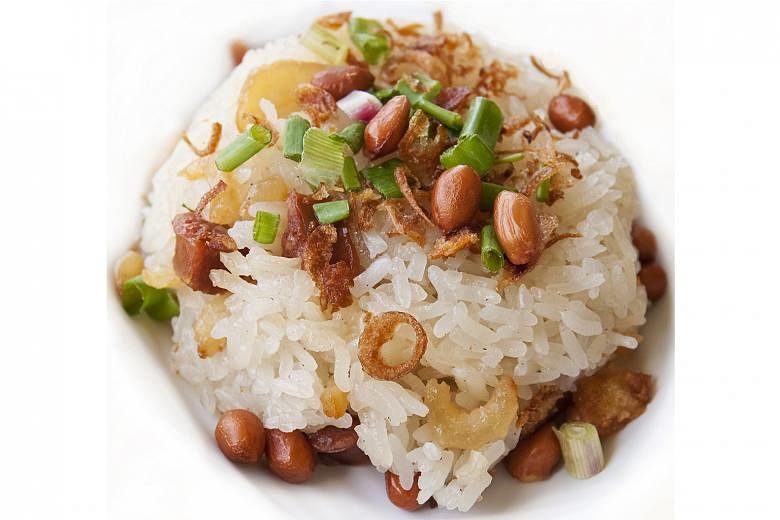White rice is very much in the news these days, after a report on how eating this beloved staple on a regular basis raises the risk of diabetes.
The quality of a person's diet can be improved by replacing refined carbohydrate intake with whole grains, says the Health Promotion Board (HPB).
According to the 2010 National Nutrition Survey, 52 per cent of Singaporeans' dietary energy come from carbohydrates, which is mainly made up of refined staples such as white rice, noodles and white bread.
The same survey also showed that Singaporeans were consuming nine times more sugar from starchy staples such as rice and noodles than from sweet drinks, said the Health Promotion Board.
Refined carbohydrates lack fibre and hence are broken down and converted into glucose very quickly, resulting in a spike in blood sugar levels.
-
What's inside
-
CALORIE CONTENT OF VARIOUS RICE TYPES (kcal per 200g serving)
-
White rice: 280
Brown rice: 238
Red rice: 246
Black rice: 268
Parboiled rice: 355
Basmati rice: 242
Glutinous rice: 194
Source: Jaclyn Reutens, dietitian, Aptima Nutrition & Sports Consultants
-
GI SCORES OF VARIOUS RICE TYPES
-
White rice: 78
Brown rice: 65-80
Parboiled rice: 38
Basmati rice: 58-65
Japonica rice: 75
Glutinous rice: 98
Source: Lynette Goh, senior dietitian, National Healthcare Group Polyclinics
An HPB spokesman said: "Over time, this imposes a significant burden on our body, leading to eventual fatigue of the insulin- producing cells of the pancreas which, in turn, leads to the development of diabetes."
To prevent obesity and diabetes, people need to improve the quality of carbohydrates consumed, as well as ensure that their overall diet is balanced.
They also need to limit the consumption of alcohol and foods that are high in added sugar and saturated fat, as well as exercise regularly.
Mind & Body takes a look at the different types of rice commonly found in Singapore.
- This is the first of a two-part series on rice and noodles. We will look at the calorie and nutritional content of noodles next.
1. WHOLE GRAINS
Quinoa and millet are whole grains, like unpolished rice. Like rice, they contain bran, germ and endosperm, said a Health Promotion Board spokesman.
When rice is refined, the bran and the germ are removed, leaving only the soft white endosperm, he said.
The endosperm contains starchy carbohydrates, proteins and small amounts of vitamins and minerals.
"By removing the bran and germ, white rice contains more calories for the same weight of its whole grain counterpart," he added. "Conversely, quinoa or millet would contain more nutrients, but fewer calories for the same weight of white rice."
Quinoa has a lower glycaemic index (GI) than white rice. Millet has a medium to high GI, said Ms Jaclyn Reutens, a dietitian from Aptima Nutrition & Sports Consultants. Still, these are grains that can add variety to a person's diet. A healthy diet is also a varied diet.
2. WHITE RICE
This is rice that is milled to remove the hull, bran and germ. Long-grain Thai white rice is the most popular type of rice eaten in Singapore.
Apart from the processing, the length of a rice grain, whether it is long, medium or short, also has an impact on one's blood sugar level.
Long-grain rice tends to have a lower GI than short-grain ones. The GI measures how carbohydrates in food are converted into glucose.
A food with a high GI score of 70 and above would raise a person's blood glucose more than a food with a low GI of below 55.
Short-grain rice has a short plump kernel and the grains tend to stick together after cooking. This variety is commonly found in Japanese and Korean cuisine.
Ms Reutens said diabetics should avoid this type of rice as the grains are digested quickly, causing a spike in blood glucose level.
Medium-grain rice has a longer kernel than short-grain rice, and can be used in puddings and desserts. The grains also tend to cling together after cooking. The GI is lower than for short-grain rice, said Ms Reutens.
Long-grain rice has a longer, slender kernel and the grains tend to separate after cooking. The GI is lower than for medium and short- grain rice and the longer digestion time keeps a person full longer.
Together with other healthy foods such as vegetables and protein, white rice can make a healthy meal, even though it may have less fibre than other grains, said Ms Lynette Goh, senior dietitian, National Healthcare Group Polyclinics.
"We generally do not ask patients to avoid white rice. We encourage them to try brown rice or mix some brown rice or other grains such as quinoa or oats with the white rice to increase the fibre content," she said.
3. BROWN RICE
Brown rice is whole grain rice.
Only its husk or the outer hull, and not its bran layer and germ, is removed.
The bran and the germ contain important antioxidants, B vitamins, minerals and fibre.
"Brown rice is healthier in terms of its higher fibre, vitamin and mineral content," said Ms Reutens.
Replacing as little as 20 per cent of a bowl of white rice with brown rice can help Asians, who are genetically more predisposed to diabetes, reduce the risk of diabetes, said the HPB.
Whole grain rice comes in a variety of colours, including brown, red, purple or black.
White rice usually has a high GI. Brown rice can have a medium to high GI, red rice has a medium GI and black rice has a low GI, according to Ms Goh.
Whole grains such as brown rice are especially helpful for diabetics who are trying to control their blood sugar level, said the HPB spokesman.
"This is because whole grains and fibrous foods such as fruit and vegetables take a longer time - three to four hours - to convert the carbohydrates to glucose after being consumed."
Some people link the regular consumption of brown rice to increased chances of developing osteoporosis because it contains phytates, which inhibits the absorption of several minerals, including calcium.
However, the HPB spokesman added, the amount of brown rice consumed in our diet is far from a threshold where we have to be concerned with phytates limiting nutrient absorption.
"In fact, recent studies have shown that the intake of phytates in our diet is minimal and does not affect the body's intake of minerals such as calcium," he said.
"The benefits of increasing whole grain intake in our diet, at a 20 per cent replacement level, for example, far outweigh any concerns of calcium losses due to phytates."
4. PARBOILED RICE AND OTHER RICE TYPES
Parboiled rice is parboiled before refining, a process which drives some of the B vitamins into the endosperm so that they are not lost when the bran is removed, said the US-based Whole Grains Council.
"As a result, converted rice is healthier than regular white rice, but still is lacking many nutrients found in brown rice," it said.
Other types of rice eaten here include glutinous rice, a short-grain rice that is extremely sticky when cooked. It is often used to make rice dumplings.
It is lower in calories than white or brown rice but has a high GI score of 98, said Ms Goh.
Basmati rice, a long-grain aromatic Indian rice, has more amylose (which is harder for the digestive system to break down) than white rice or glutinous rice.
It does not stick together after cooking.
Basmati rice has a GI score of 58 to 65, while parboiled rice has a GI score of 38, said Ms Goh.





